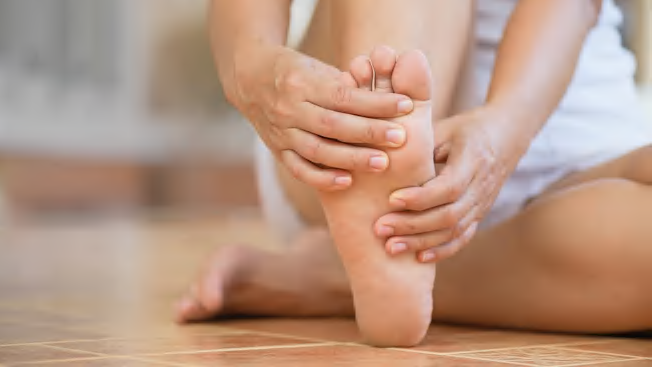What Really Works for Nerve Pain
The right fixes for numbness or tingling in your hands or feet

Have you experienced pain or tingling in your hands or feet? Those are signs of possible neuropathy, “a general term for nerve dysfunction in your limbs,” says Eva Feldman, MD, PhD, a professor of neurology at the University of Michigan Medical School in Ann Arbor.
The likelihood of neuropathy appears to increase with age. That’s partly because the number of nerve cells in your body declines over the years, and those that remain become less functional. And “if they are damaged by injury or an underlying medical condition, they struggle more to recover,” says Anne Louise Oaklander, MD, PhD, an associate professor of neurology at the Harvard Medical School.
Spotting the Signs
Tingling or painful sensations in your hands and/or feet are the main symptoms. “Patients often describe it feeling like ants crawling on their feet, or even as prickling or burning,” Feldman says. Another red flag is numbness in your hands or feet that leaves you feeling unsteady.
If you have any of the above, call your doctor right away. That’s especially important if you have a chronic condition such as type 2 diabetes or you’re being treated with certain chemotherapy drugs.
Getting Diagnosed
Your primary care practitioner will examine you, including the skin on your hands and feet to look for fissures or cracks. They’ll test your reflexes and might use a tuning fork in the area to see if you can feel the vibration or prick you with a pin to see if you feel pain. They might check the strength in your hands and feet as well.
If any results are abnormal, you’ll probably have tests of your nerves for confirmation, and if those results are abnormal, blood tests to check for contributing conditions such as type 2 diabetes, Oaklander says. If the neuropathy is on only one side or is worse on one side, Feldman says, you’ll need to see a neurologist to rule out more serious conditions such as amyotrophic lateral sclerosis.
Finding Relief
How your neuropathy is treated usually depends on the cause, Feldman says. If it’s type 2 diabetes, exercise and weight loss, if needed, can improve symptoms, according to a 2022 review in the journal Lancet Neurology. Neuropathy due to an autoimmune disorder, hypothyroidism, or a vitamin B12 deficiency often eases once the underlying condition is corrected. If it’s caused by chemotherapy, your doctor may change your regimen or advise a treatment break.
If those steps aren’t enough, medication may help. The American Academy of Neurology advises trying tricyclic antidepressants like amitriptyline, serotonin norepinephrine reuptake inhibitors such as duloxetine (Cymbalta) and venlafaxine (Effexor ER), or gabapentinoids like gabapentin (Neurontin and others). A topical prescription capsaicin patch helps, but it can cause a rash or burning sensation.
If you have foot neuropathy, you should see a podiatrist several times a year to have your feet checked for sores, ulcers, and signs of infection. You should also examine your feet daily.
And if you’re 50 or older, make sure to get Shingrix, the two-dose shingles vaccine. Shingles can cause a painful condition called postherpetic neuralgia, which has similar symptoms to neuropathy, Feldman says. Shingrix has been found to be more than 90 percent effective at preventing it in people who get shingles.
Editor’s Note: This article also appeared in the October 2024 issue of Consumer Reports On Health.

















